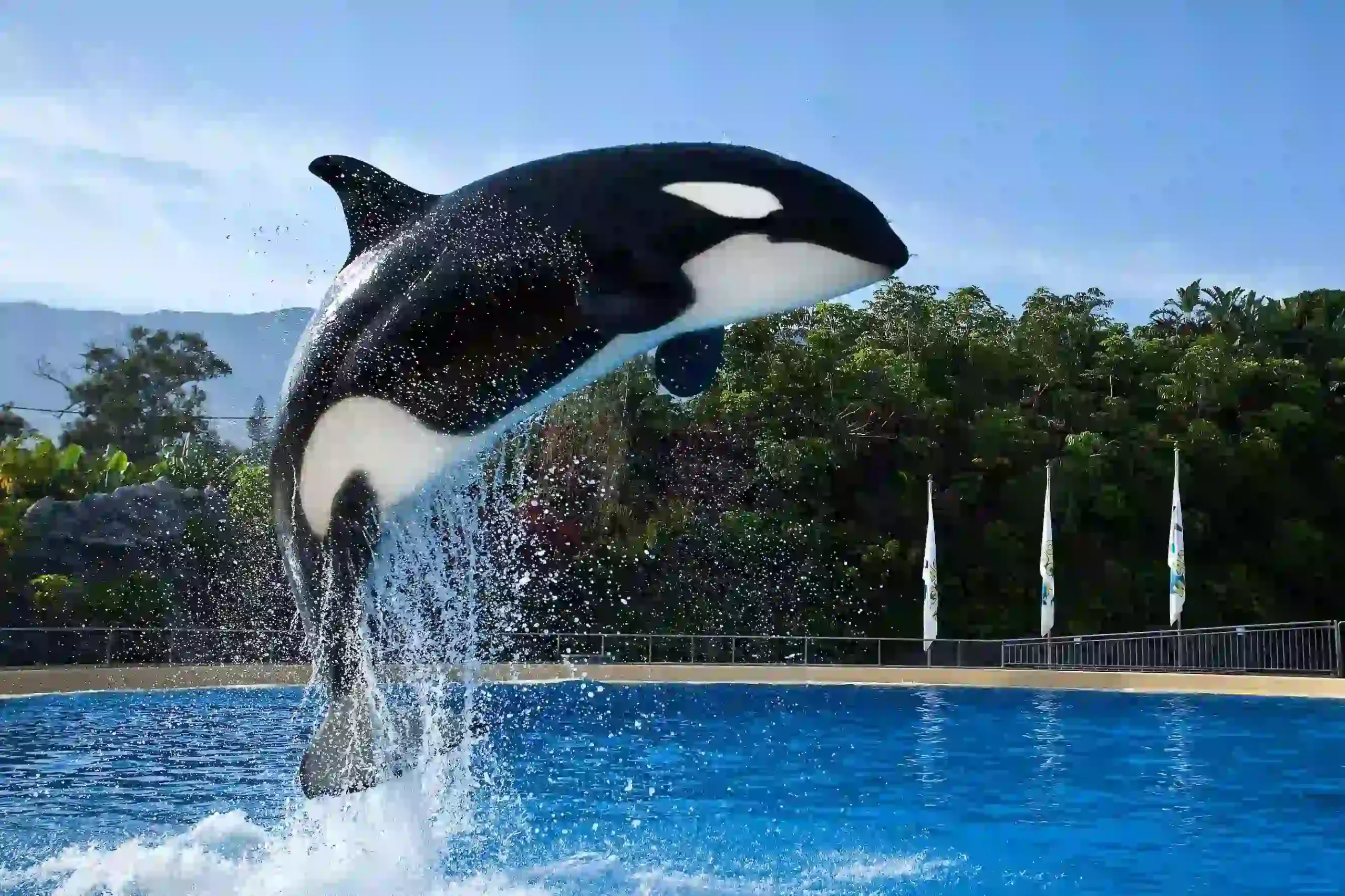Although commonly known as killer whales, orcas are actually the largest members of the oceanic dolphin family. Their size, intelligence, and teamwork make them formidable apex predators.
Orcas
Orcinus orca
Orcinus orca
Orcas are the largest type of dolphin in existence and without doubt among the most formidable predators in the animal kingdom. Instantly recognisable thanks to their striking black-and-white markings, these marine giants combine both strength and elegance. Highly social and remarkably intelligent, they are known for producing distinctive calls that can be recognised by members of their pod from miles away.
What is more, orcas possess exceptional echolocation skills. By emitting sounds that travel through the water and bounce back from objects, they are able to determine an object’s location, size and even its shape – an ability that proves invaluable for both communication and hunting.
Although there is only a single recognised species, scientists have identified as many as 10 distinct ecotypes. These ecotypes vary considerably in size, habitat, colouration patterns, vocalisations, hunting strategies and even the shape of their dorsal fins. In other words, while all orcas belong to the same species, their lifestyles and behaviours can be as different as chalk and cheese.

WEIGHT
Males: up to 5,568 kg
Females: around 3,810 kg

ALIMENTACIÓN
Carnivorous

DISTRIBUTION
Oceans and seas across the world

GESTATION
15-18 months
Although they are often associated with cold, coastal waters, orcas can be found in an extraordinary range of habitats – from the icy polar regions all the way to the equator. Sitting firmly at the top of the food chain, they enjoy a remarkably varied diet and are more than capable of feasting on fish, penguins, seals and even sea lions, using teeth that can grow up to ten centimetres in length.


Female orcas reach sexual maturity between the ages of 6 and 10, while males mature somewhat later, usually between 10 and 13 years. In order to secure a mate, males often compete directly with one another.
Orcas are highly protective animals. Mothers are known to guard their calves closely, while adolescent females frequently lend a hand in looking after the newborns. Calves are usually born every three to ten years, following a pregnancy lasting around 17 months. Typically, a single calf is delivered and may be nursed for up to two years.
The first year of an orca’s life is particularly fragile; it is estimated that nearly half of all calves die during this period. Yet the exact cause of such high mortality remains uncertain. At birth, a calf weighs in at roughly 200 kg and measures around 2.5 metres in length.
As time goes by, the bond between mother and calf may gradually fade, eventually leading the young orca to strike out on its own. That said, in some pods, calves remain with their family group throughout their entire lives.
Orcas are found in oceans and seas across the globe, showing an extraordinary ability to adapt to a wide range of marine conditions. There are different groups with distinct movement patterns. Some orcas are considered resident, meaning they remain within specific, localised ranges – for instance, those living in the Strait of Gibraltar. Others, by contrast, are transient, travelling across much larger areas with movements that are far less predictable.
This diversity in their way of life is closely linked to factors such as the availability of food and the particular conditions of their marine environment.
Morgan
FEMALE
Tekoa
MALE
Adán
MALE
Teno
MALE

Not whales, but dolphins
Although commonly known as killer whales, orcas are actually the largest members of the oceanic dolphin family. Their size, intelligence, and teamwork make them formidable apex predators.
They have dialects
Each pod of orcas develops its own distinctive set of sounds and vocalisations — almost like a unique language. These “dialects” are passed down through generations, allowing members to recognise one another and coordinate their behaviour within the group.
Highly coordinated hunters
Orcas are apex predators and make use of extremely sophisticated hunting strategies. For example:
They adapt to their environment
Orcas display different “cultures” depending on where they live. Each ecotype specialises in particular prey and has its own behaviour, diet, and slightly distinct appearance.
They can live as long as humans
Orcas are long-lived animals with lifespans comparable to humans. Female orcas typically live between 50 and 90 years, although some individuals are believed to have surpassed 100. Males usually live between 30 and 60 years.
The tallest dorsal fin of all cetaceans
One of the orca’s most distinctive features is its striking dorsal fin, which can reach up to 1.8 metres in height — the tallest among all cetaceans. Made entirely of dense connective tissue, the fin helps stabilise the animal as it swims at high speeds.

As part of our educational and awareness work on biodiversity, we have developed an encyclopaedia about cetaceans. This comprehensive document offers scientific data and insights into their behaviour, as well as the myths and facts surrounding these fascinating animals.

Certificado de bienestar animal de la Asociación Británica de Agentes de Viajes (ABTA)

Certificado Europeo por la Responsabilidad Ambiental desde 2005

Certificado Humane Conservation con la máxima calificación al mejor parque zoológico de Europa American Humane Association (AHA) EEUU

Certificados desde 2008 por el Instituto de Turismo Responsable y desde 2021 cumpliendo con las acciones Biosphere LifeStyle alineadas con los 17 Objetivos de Desarrollo Sostenible de la Agenda 2030 de las Naciones Unidas

ISO 9001 – Certificado TUV Rheinland Sistema de gestión de calidad certificado respecto a la norma ISO 9001 desde 2013 ISO 14001 y Certificado TUV Rheinland por el alto respeto al Medio Ambiente desde 2005